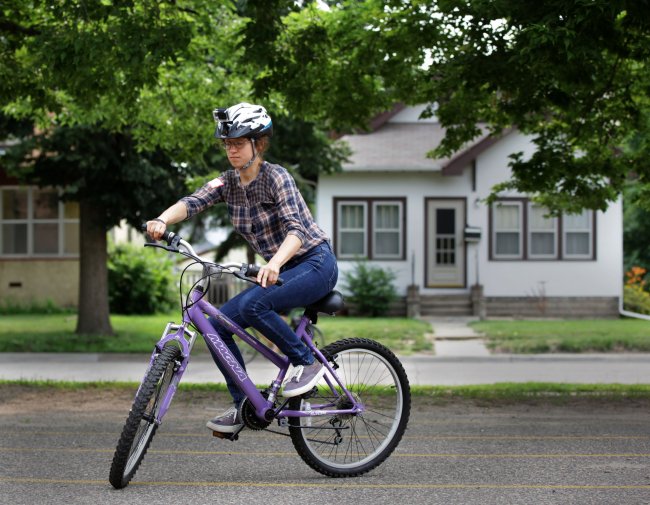MINNEAPOLIS ― For many, learning how to ride a bike is a rite of passage. For others, it never happens. Now, some adults are finding out what they’ve been missing.
Sheldon Mains is helping adults take care of that unfinished childhood business.
In a metro area known for its thriving bike culture, Mains discovered that there’s a surprisingly large number of adults who have little or no experience on two wheels.
As an avid cyclist, he’s trying to change that. Two years ago, Mains worked with a neighborhood group to establish a community bike center in Minneapolis. That center, SPOKES, offers free learn-to-ride classes for adults and teens that focus on what Mains calls the three basics of biking: balance, braking and the rules of the road.
 |
Asya Kosygina pedals through the first lesson of a Learn-to-Ride bike class at Matthews Park in Minneapolis on July 19. (Minneapolis Star Tribune/MCT) |
The majority of students aren’t native Minnesotans. Many come from areas where biking wasn’t popular or affordable. But Mains believes that something as simple as a bicycle can offer independence.
Biking, he said, is all about “empowerment, freedom and joy.”
Here are some stories of the students.
Sumitra Ramachandran:
It wasn’t the food or the weather or even the language that shocked Sumitra Ramachandran the most about her new home ― it was the bikes.
“When I saw people (on bikes) it was weird, really different,” said Ramachandran, who moved from India to Minneapolis two years ago.
Riding bicycles in India is common for kids, but as soon as young adults can drive, they trade two wheels for four. While Ramachandran, now 38, had childhood friends with bikes, she and her brother just never learned.
“And once I was older, I thought it wouldn’t be easy to learn,” she said. “I started driving and never had a chance to go back to biking.”
Now, as a graduate student at the University of Minnesota, she depends on the bus, but that’s not always convenient. If she misses a bus, she’s stuck waiting 30 minutes for the next one. So she decided that she lived close enough to the university to try biking. “If I have a chance, I have to learn it,” she told herself.
She googled classes, found SPOKES and signed up for the program. She also started attending clinics on how to make simple bike repairs.
“Biking gives you more independence on what you want to do,” Ramachandran said. “Which is exactly what I want.”
Asya Kosygina:
Asya Kosygina has always been a walker.
While she was growing up, she and her Russian immigrant family crisscrossed the United States. A bicycle was never in the picture, so she learned early on to rely on her own two feet.
Even when she moved to Minneapolis six months ago to study art history at the University of Minnesota, the 22-year-old kept walking. About 20 km a day.
“I have some nice calluses now,” she said.
She has tried to learn how to ride a bike several times. One summer, when she was visiting Russia, her grandfather tried to teach her. She somehow went flying into a field, which “put a damper on any romantic idea I had of biking at a young age,” she said.
Later, when visiting friends in San Francisco, she took a midnight bike ride on the back of a tandem. She liked the feel of it.
When she landed in Minnesota, she made a decision: “I’ve been dancing around this issue long enough.”
She walked into a bike shop and asked where she could learn. They pointed her to SPOKES and, after spending some time there, she signed up because it was “a place that could actually teach me how to ride from start to finish.”
Halfway through her first class, she was pedaling around the blacktop.
“It was empowering, this thing I was gearing myself up to was much easier than I thought it would be,” she said.
Now, she’s planning to build her own bike. Until then, she’ll keep walking.
Vanessa Laven:
The moment Vanessa Laven found out she was cancer-free, she made a bucket list:
Buy a house.
Go rock climbing.
Move to a new city.
At the top of the list? Learning how to ride a bike.
“I want to have kids and not have them ask their father about that because I don’t know the first thing about riding a bike,” said Laven, 29.
Laven grew up in a “rough neighborhood” of New Jersey where bike theft was common. “I always had this feeling as a kid that the troublemaker, obnoxious kids had bikes,” she said.
So Laven got a pair of roller skates. They were less likely to be stolen, easier to store and cheaper for her parents, who immigrated from Cuba, to buy. Besides, “everybody was on roller skates,” she said. “It was the ’90s ― that’s just what we did.”
When Laven moved to Minnesota last year, she noticed everyone was biking. “It wasn’t just skinny hipsters riding bikes,” she said. “It was older people, too.”
In 2011, she found out she was in remission from stage 2 non-Hodgkins lymphoma, and made her list.
“A lot of the things were quintessential American, in my mind,” Laven said. “And as a child of immigrants, it was all so foreign to me, like riding a bike.”
She saw a notice about the learn-to-ride classes in a community bulletin and knew it was for her.
“That’s one thing I can check off that I never did as a kid.”
By Karen Zamora
(Star Tribune (Minneapolis))
(MCT Information Services)








